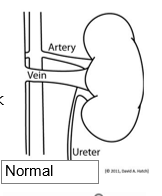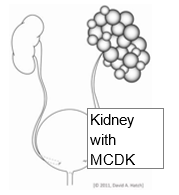Multicystic Dysplastic Kidney (Multicystic Kidney or Multicystic Renal Dysplasia)
(Multicystic kidney or multicystic renal dysplasia)
What is multicystic dysplastic kidney (MCDK)?

Multicystic dysplastic kidney (MCDK) is a condition in which parts of the kidney are replaced by cysts. There are many cysts of all different sizes.
These cysts don’t let the kidney filter blood and make urine like it should. This normally only affects one of the kidneys. Your baby will have little effects if they have one healthy kidney, even if the other one has MCDK.
What causes MCDK? 
- The cause of MCDK is often not known.
- Urine moves from the kidney to a tube that goes to the bladder. This tube is called the ureter. One cause of MCDK is thought to happen when the flow of urine is blocked.
- It is not caused by anything the mother did or did not do.
How is it diagnosed?
Prenatal diagnosis of MCDK
- Most MCDK cases are diagnosed by ultrasound before a baby is born. During a routine ultrasound, your doctor may suspect that something is wrong with the kidney(s). You will see a specialist called a maternal-fetal medicine specialist who handles high risk pregnancies. This doctor will use a special ultrasound to confirm the diagnosis. The ultrasound looks at your baby’s kidneys. The doctor will also look at the rest of your baby’s body.
- About half of babies with MCDK will have another problem related to the kidneys. Most of these problems are with the other kidney and are minor, but they will require follow-up after your baby is born.
How does MCDK affect my baby?
After birth, your baby will be examined. Close follow-up care is very important to make sure your baby stays healthy.
A kidney with MCDK should slowly shrink. The doctors will look at the kidneys using a renal ultrasound every 3 to 4 months during your baby’s first year. They will also look at the kidneys through a voiding cystourethrogram (VCUG). This is a special x-ray that watches the filling and emptying of the bladder. It will show if the urine flows backward towards the kidneys.
Very rarely, a cancerous growth occurs on the affected kidney.
Another very rare problem is high blood pressure (hypertension).
How is it treated?
Treatment will vary. Your baby will have ultrasounds. This is done to watch the affected kidney very closely for changes in size. Your baby’s other kidney will also be watched closely to see how well it makes urine. Most often, surgery is not needed. Instead, doctors watch the kidney to see if it shrinks as expected. Rarely, the kidney may need to be removed. Your doctor will talk with you if this is recommended.
What is my baby's long-term outlook?
A baby with MCDK in only one kidney and no other problems has a normal life expectancy. For a child with only one kidney that works, that kidney should be a little bigger than normal.
- Many people live normal lives with only one healthy kidney. It is important that your child has regular doctor visits to be sure that the remaining kidney is working well.
- Your child’s blood pressure should be checked at least once each year. High blood pressure that is not treated may damage the healthy kidney.
- Your child’s doctor will talk with you about how it will affect your child’s future health and activities.
Your child will need follow-up care for life. These are also important for kidney health:
- Help your child follow a general healthy diet. They should stay hydrated.
- Limit use of non-steroidal anti-inflammatory medicines (Aleve, Advil, Ibuprofen, Naproxen, Toradol/Ketorolac). These medicines can be used, but should be used sparingly.
- Once your child uses the toilet, annual screening for blood pressure and urinalysis should be part of well-child exams. If they have hypertension or proteinuria they should follow up with Nephrology.
- Safe driving practices, including seatbelt use, are important. The highest risk activity for renal trauma is motor vehicle accidents. Renal trauma can cause major problems for overall kidney function.
- Activity restrictions are not required.



